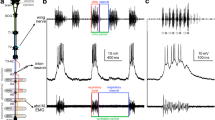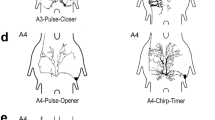Summary
-
1.
When male field crickets (Gryllus campestris L.) sing, abdominal respiration is usually synchronized with the chirps of the calling song. These experiments were designed to find a neuronal correlate of this synchronization.
Animals with freely moving wings and abdomen are caused to produce normal song by brain lesions, during which the activity of single fibers in the cervical connectives is recorded extracellularly together with the myograms of the wing muscles and the expiratory abdominal flank muscles.
-
2.
In each of three animals a descending neuronal spike pattern was found (I, II, III, respectively) in which bursts of impulses alternate with the chirps and the corresponding abdominal ventilatory activity (AVA). In silent males the bursts alternate with the AVAs and other abdominal movements.
-
3.
The beginning of the neuronal burst is correlated with the end of the preceding chirp, no matter how long it is, and the end is correlated with the onset of the following chirp. The relationship to the chirp-coupled AVA is less clear-cut.
-
4.
The muscle potentials in the chirp-coupled AVA are grouped so as to resemble the syllable pattern (animal I). Between these groups increasing numbers of neuronal impulses appear toward the end of the chirp. When the chirp is shifted with respect to the AVA, the spikes continue to follow the syllable rhythm.
-
5.
A relation between Pattern I and the AVA becomes evident in the case of AVAs lasting through two chirps. The neuron fires more rarely during such AVAs than it does between AVAs coupled to a single chirp.
-
6.
In silent males the neuronal burst both ends and begins later with respect to the AVA, and the discharge rate is lower.
-
7.
After transection of all nervous connections to thorax and abdomen Patterns I and II are irreversibly altered. That is, the correlation of the neuronal pattern with the motor patterns must require ascending inputs from these regions. During singing these inputs would have to be correlated primarily with the rhythm of stridulation, whereas in the silent phase they would be correlated with the activity rhythm of the abdominal dorsoventral muscles alone.
Similar content being viewed by others
Abbreviations
- AVA :
-
abdominal ventilatory activity
References
Bacon JP, Möhl B (1979) Activity of an identified wind interneurone in a flying locust. Nature 278:638–640
Bentley D (1969a) Intracellular activity in cricket neurons during generations of behaviour patterns. J Insect Physiol 15:677–699
Bentley D (1969b) Intracellular activity in cricket neurons during generation of song patterns. Z Vergl Physiol 62:267–283
Bentley D (1977) Control of cricket song patterns by descending interneurons. J Comp Physiol 116:19–38
Burrows M (1975a) Coordinating interneurons of the locust which convey two patterns of motor commands: their connexions with flight motoneurons. J Exp Biol 63:717–733
Burrows M (1975b) Coordinating interneurons of the locust which convey two patterns of motor commands: their connexions with ventilatory motoneurons. J Exp Biol 63:735–753
Elsner N (1969) Kommandofasern im Zentralnervensystem der HeuschreckeGastrimargus africanus (Oedipodinae). Zool Anz (Suppl) 33:465–471
Elsner N, Popov AV (1978) Neuroethology of acoustic communication. Adv Insect Physiol 13:229–335
Gerstein GL, Kiang NYS (1960) An approach to the quantitative analysis of electrophysiological data from single neurons. Biophys J 1:15–28
Hedwig B, Elsner N (1980) A neuroethological analysis of sound production in the acridid grasshopper,Omocestus viridulus. Adv Physiol Sci 23:495–514
Huber F (1955) Sitz und Bedeutung nervöser Zentren für Instinkthandlungen beim Männchen vonGryllus campestris L. Z Tierpsychol 12:12–48
Huber F (1960a) Experimentelle Untersuchungen zur nervösen Atmungsregulation der Orthopteren (Saltatoria: Gryllidae). Z Vergl Physiol 43:359–391
Huber F (1960b) Untersuchungen über die Funktion des Zentralnervensystems und insbesondere des Gehirnes bei der Fortbewegung und Lauterzeugung der Grillen. Z Vergl Physiol 44:60–132
Hustert R (1974) Morphologie und Atmungsbewegung des 5. Abdominalsegmentes vonLocusta migratoria migratorioides. Zool Jahrb Abt Allg Zool Physiol Tiere 78:157–174
Hustert R (1975) Neuromuscular coordination and proprioceptive control of rhythmical abdominal ventilation in intactLocusta migratoria migratorioides. J Comp Physiol 97:159–179
Kien J (1980) Mechanisms of motor control by plurisegmental interneurons in locusts. J Comp Physiol 140:303–320
Klapp G (1974) Elektrophysiologische Untersuchungen zur Kontrolle der Lauterzeugung und der Atmung von Grillen. Diplom Thesis, Technische Hochschule Darmstadt
Kutsch W (1969) Neuromuskuläre Aktivität bei verschiedenen Verhaltensweisen von drei Grillenarten. Z Vergl Physiol 63:335–378
Kutsch W, Otto D (1972) Evidence for spontaneous song production independent of head ganglia inGryllus campestris L. J Comp Physiol 81:115–119
Miller PL (1974) Respiration — aerial gas transport. In: Rockstein M (ed) Physiology of insecta, vol 6. Academic Press, New York, pp 345–402
O'Shea M, Rowell CHF (1977) Complex neural integration and identified interneurons in the locust brain. In: Hoyle G (ed) Identified neurons and behavior of arthropods. Plenum Press, New York London, pp 307–328
Otto D (1967) Untersuchungen zur nervösen Kontrolle des Grillengesanges. Zool Anz (Suppl) 31:585–592
Otto D (1969) Hirnreizinduzierte komplexe Verhaltensfolgen bei Grillen. Zool Anz (Suppl) 33:472–477
Otto D (1971) Untersuchungen zur zentralnervösen Kontrolle der Lauterzeugung von Grillen. Z Vergl Physiol 74:227–271
Otto D (1978) Änderungen von Gesangsparametern bei der Grille (Gryllus campestris L.) nach Injektion von Pharmaka ins Gehirn. Verh Dtsch Zool Ges 1978:245
Otto D, Campan R (1978) Descending interneurons from cricket subesophageal ganglion. Naturwissenschaften 65:491
Rowell CHF (1963) A method for chronically implanting stimulating electrodes in the brain of locusts, and some results of stimulation. J Exp Biol 40:271–284
Robertson RM, Moulins M (1981) Oscillatory command input to the motor pattern generators of the crustacean stomatogastric ganglion. J Comp Physiol 143:453–463
Selverston AI, Miller JP (1980) Mechanisms underlying pattern generation in the lobster stomatogastric ganglion. Adv Physiol Sci 23:345–368
Simmons P (1981) Ocellar excitation of the DCMD: An identified locust interneurone. J Exp Biol 91:355–359
Vowles DM (1964) Models and the insect brain. In: Reiss RF (ed) Neural theory and modelling. Stanford University Press, Stanford, pp 377–399
Wadepuhl M (1980) Kontrolle des akustischen Verhaltens einheimischer Feldheuschrecken (Gomphocerus rufus L.) durch das Gehirn. Doctoral Dissertation, Universität München
Weber T (1978) Vergleich der Lockgesänge von drei Grillenarten im Hinblick auf artspezifisches Erkennen in der Phonotaxis der Weibchen. Verh Dtsch Zool Ges 1978:176
Wilson DM, Wyman JR (1965) Motor input patterns during random and rhythmic stimulation of locust thoracic ganglia. Biophys J 5:121–143
Author information
Authors and Affiliations
Additional information
Supported by the Deutsche Forschungsgemeinschaft within the SPP “Neurale Mechanismen des Verhaltens” (Ot 62/4)
Rights and permissions
About this article
Cite this article
Otto, D., Weber, T. Interneurons descending from the cricket cephalic ganglia that discharge in the pattern of two motor rhythms. J. Comp. Physiol. 148, 209–219 (1982). https://doi.org/10.1007/BF00619127
Accepted:
Issue Date:
DOI: https://doi.org/10.1007/BF00619127




